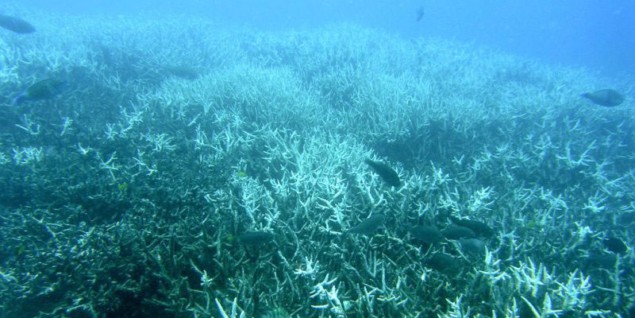
Coral reefs have always lived near the edge. Now, thanks to global warming, life there is five times more precarious.
Forty years ago, the world’s coral reefs faced a known risk: every 25 or 30 years, ocean temperatures would rise to intolerable levels.
Corals would minimise the risk of death by everting the algae with which they lived in symbiotic partnership: that is, the reef animals would avoid death by getting rid of the algae, deliberately weakening themselves.
This response is known as bleaching, and it can have a catastrophic effect on other life on the reef. In the Pacific such episodes were sometimes linked to cycles of ocean warming known as an El Niño event.
By 2018 the odds had altered. Coral reefs now face this hazard every six years. That is, in four decades of global warming and climate change, the risks have multiplied fivefold.
Bleaching breaks out
“Before the 1980s, mass bleaching of corals was unheard of, even during strong El Niño conditions, but now repeated bouts of regional-scale bleaching and mass mortality of corals has become the new normal around the world as temperatures continue to rise,” said Terry Hughes, who directs Australia’s Centre of Excellence for Coral Reef Studies at James Cook University.
He and colleagues report in the journal Science that they analysed data from bleaching events at 100 locations around the planet between 1980 and 2016. Bleaching events are a fact of life for corals: these little creatures tend to live best in temperatures near the upper limit of their tolerance levels, and respond to extreme events by rejecting the algae that normally provide the nutrients they need.
But as global air temperatures have increased, in response to profligate burning of fossil fuels that increase greenhouse gas levels in the atmosphere, so have sea temperatures. And Professor Hughes and his team report that in the last two years more than a third of all bleaching events have been “severe,” extending over hundreds of kilometres.
When they measured the growth of risk over the decades, they found that the bleaching hazard had increased by 4% per year since 1980.
The finding should be no surprise. In 2015, during a severe El Niño event, scientists began to record cases of coral death. In 2016, they observed that 93% of Australia’s Great Barrier reef had been affected. In 2017 they found that reefs in the western Pacific and off the Indian Ocean had been damaged beyond repair, and a separate set of calculations has warned that by 2100, up to 99% of the world’s coral colonies could be at risk of bleaching every year.
Reefs can recover, but this recovery can take as long as a decade. Coral reefs are among the planet’s richest habitats, and the death of a reef puts many ocean species at risk: it also damages local commercial fish catches and local tourist industries.
“Reefs have entered a distinctive human-dominated era – the Anthropocene,” said Mark Eakin of the US National Oceanic and Atmospheric Administration, a co-author. “The climate has warmed rapidly in the past 50 years, first making El Niños dangerous for corals, and now we’re seeing the emergence of bleaching in every hot summer.”
And Professor Hughes said: “We hope our stark results will help spur on the stronger action needed to reduce greenhouse gases in Australia, the United States and elsewhere.” – Climate News Network
• This report was first published in Climate News Network



